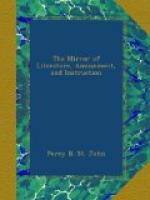Few particulars of its representative history are worth relating. The borough returned members to Parliament 23rd Edward I., and then intermitted till 34th Edward III., since which time it has constantly returned. By the return 1 Henry V. it appears that its representatives were with those of other boroughs elected at the county court.
Old Sarum was the property of the late Lord Camelford, who sold it to the Earl of Caledon. The suffrage is by burgage-tenure. The voters, seven, are nominated by the proprietor; but (says Oldfield) actually only one.
The population of Old Sarum is included in the parish, and is not distinguished in its returns.
The proprietor is Lord Caledon; and the members in the last parliament were J.J. and J.D. Alexander, who were again returned at the recent election.
The Cut is an accurate view of the old borough, with Salisbury Cathedral in the distance.
* * * * *
Bramber is here represented by the forlorn ruins of its Castle. It is in the hundred of Steyning, rape of Bramber, Sussex, and is half a mile from Steyning. It sent members as early as the two previous boroughs; it afterwards intermitted sending, and sometimes sent in conjunction with Steyning, before the 7th Edward IV. There is much “tampering” in its representative records: in 1700, one Mr. Samuel Shepherd was charged with these matters here, and in Wiltshire and Hampshire, when he was ordered to the Tower of London; but a week afterwards, Mr. Shepherd was declared to have absconded. In 1706, a Mr. Asgill, one of the Bramber members, was delivered out of the Fleet by his parliamentary privilege, and the aid of the Sergeant-at-Arms and his mace; but in the following month he was expelled the house for his writings.
The right of election is in resident burgage-holders; and the number of voters is stated to be twenty. The place consists of a few miserable thatched cottages. The Duke of Norfolk is lord of the manor. The cottages are one half of them the property of the Duke of Rutland, and the other of Lord Calthorpe, who, since the year 1786, have each agreed to send one member.[3]
[3] It is related, that in
an election contest, in 1786, the
tenant of one of the cottages
had the integrity to reject L1,000
for his vote.
The history of the Castle seen in the Cut merits note, especially as it is the only relic of the former consequence of the place. It was the baronial castle of the honour of Bramber, which, at the time of the Conqueror’s survey, belonged to William de Braose, who possessed forty other manors in this county. These were held by his descendants for several generations by the service of the knights’ fees; and they obtained permission to build themselves a castle here; but the exact date of its erection is not known. Its ruins attest that it was once a strong and extensive edifice. It appears to have completely covered the top of a rugged eminence, which commands a fine view of the adjacent country and the sea, and to have been surrounded by a triple trench. The population of Bramber is in the Returns of 1821—ninety-eight persons. The members in the last parliament were the Honourable F.G. Calthorpe and John Irving; at the recent election, the members returned were J. Irving and W.S. Dugdale.




